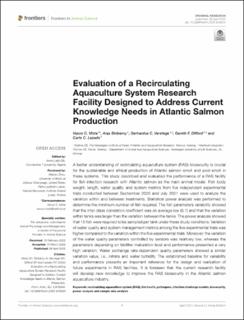| dc.contributor.author | Mota, Vasco | |
| dc.contributor.author | Striberny, Anja | |
| dc.contributor.author | Verstege, Gerhardus C. | |
| dc.contributor.author | Difford, Gareth Frank | |
| dc.contributor.author | Lazado, Carlo C. | |
| dc.date.accessioned | 2022-06-30T07:26:17Z | |
| dc.date.available | 2022-06-30T07:26:17Z | |
| dc.date.created | 2022-03-15T12:25:01Z | |
| dc.date.issued | 2022 | |
| dc.identifier.citation | Frontiers in Animal Science. 2022, 3 . | |
| dc.identifier.uri | https://hdl.handle.net/11250/3001691 | |
| dc.description.abstract | A better understanding of recirculating aquaculture systems (RAS) biosecurity is crucial for a sustainable and ethical production of Atlantic salmon smolt and post-smolt in these systems. This study described and evaluated the performance of a RAS facility for fish infection research with Atlantic salmon as the main animal model. Fish body weight, length, water quality and system metrics from five independent experimental trials conducted between September 2020 and July 2021, were used to analyse the variation within and between treatments. Statistical power analysis was performed to determine the minimum number of fish required to use. The fish parameters variability showed that the inter-class correlation coefficient was on average low (0.1) and that the variation within tanks was larger than the variation between tanks. The realized power of the five-experiment average was 47 % for length and 59 % for weight. Assuming the maximum available number of tanks to achieve a power of 80 %, a medium to large treatment effect (0.5 - 0.8) and an inter-class correlation coefficient of 0, a minimum of 15 fish sampled per tank is required for the current study conditions. Water quality and system management metrics variation among the five experimental trials was higher compared to variation within the five experimental trials. Moreover, the variation of the water quality parameters controlled by sensors was relatively low, whereas parameters depending on biofilter maturation level and performance presented a very high variation. Water exchange rate dependent quality parameters showed a similar variation value, i.e., nitrate and water turbidity. The established baseline for variability and performance presents an important reference for the design and realization of future experiments in this RAS facility. It is foreseen that the current research facility will develop new knowledge to improve the RAS biosecurity in the Atlantic salmon aquaculture industry. | |
| dc.description.abstract | Evaluation of a recirculating aquaculture system research facility designed to address current knowledge needs in Atlantic salmon production | |
| dc.language.iso | eng | |
| dc.subject | Fiskehelse | |
| dc.subject | Fish Health | |
| dc.title | Evaluation of a recirculating aquaculture system research facility designed to address current knowledge needs in Atlantic salmon production | |
| dc.title.alternative | Evaluation of a recirculating aquaculture system research facility designed to address current knowledge needs in Atlantic salmon production | |
| dc.type | Peer reviewed | |
| dc.type | Journal article | |
| dc.description.version | publishedVersion | |
| dc.source.pagenumber | 12 | |
| dc.source.volume | 3 | |
| dc.source.journal | Frontiers in Animal Science | |
| dc.identifier.doi | 10.3389/fanim.2022.876504 | |
| dc.identifier.cristin | 2009920 | |
| dc.relation.project | Norges forskningsråd: 302767 | |
| cristin.ispublished | true | |
| cristin.fulltext | original | |
| cristin.qualitycode | 1 | |
